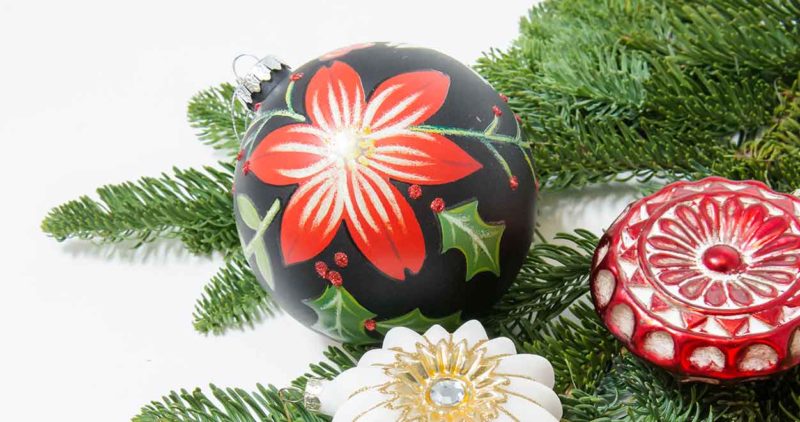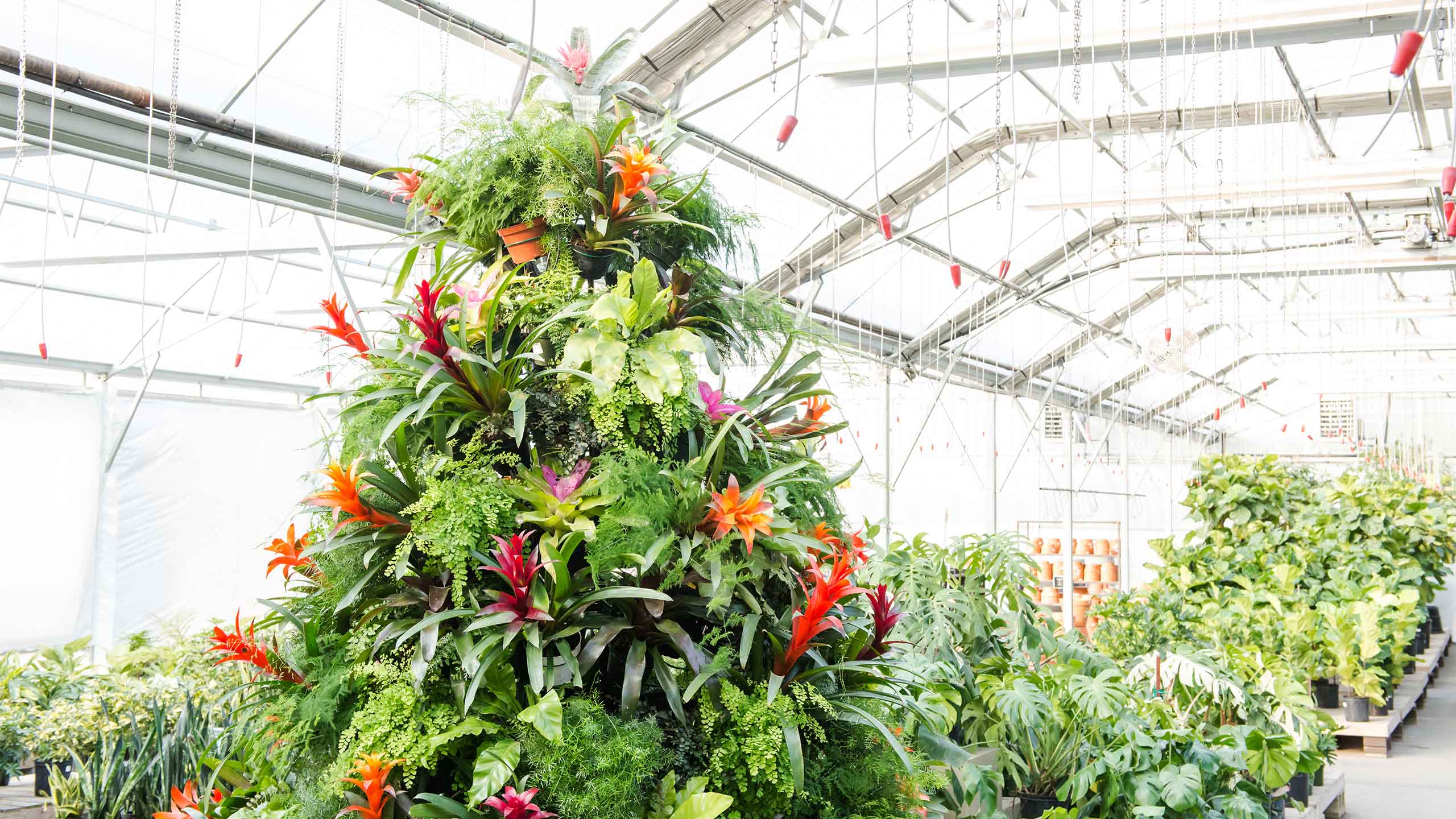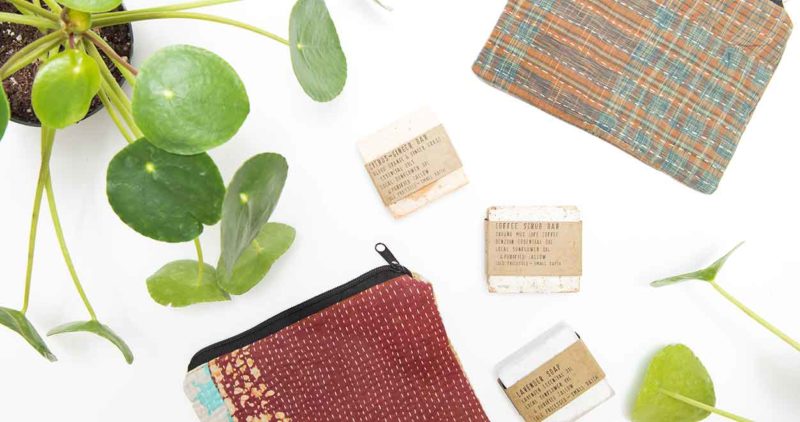
Have you seen the amazing tropical tree in the greenhouse? It’s ten feet tall and covered with over two hundred individual plants, including an assortment of bromeliads and three kinds of ferns. Although the tree is made entirely of tropical plants, the delicate greenery of the ferns – combined with the colorful bromeliads – gives it the look of a classic evergreen tree loaded with ornaments. Since we installed our tropical Christmas tree, we’ve received several questions about its construction and the plants living in it – especially the bromeliads.

These are the colorful, strappy houseplants that people love to take home for a bit of color and tropical flair – especially in the middle of winter.
Bromeliads are a diverse group of plants belonging to the plant family Bromeliaceae – a group composed of fifty-six genera and over three thousand species according to the Bromeliad Society International. Most bromeliads are native to Central and South America – including Brazil, Argentina, and Chile – and up through the Caribbean. Bromeliads can be found from sandy beaches to airless mountain tops, from parched deserts to dripping swamps. They can be terrestrial (growing in soil), saxicolous (growing on rocks), or epiphytic (growing on other plants). One very famous bromeliad – the pineapple – is even edible. Bromeliads are truly a fascinating group.
In the greenhouse, the most familiar bromeliads are in the genera Aechmea, Tillandsia, Guzmania, Neoregelia, and Vriesa. These are the colorful, strappy houseplants that people love to take home for a bit of color and tropical flair – especially in the middle of winter when little else is blooming indoors or otherwise. Bromeliads in this group can look very different from one another, but in general, they all grow in a tightly spiraled arrangement of strap-like leaves called a rosette. In many, this rosette forms a tight cup that collects water. In Aechmea, Tillandsia, Guzmania, and Vriesa, a tall colorful flower stalk emerges from the rosette too. The flower stalks are made up of layers of colorful bracts and sometimes smaller flowers appear between these bracts. In our tropical tree, we used the popular Guzmania genus with its tall and slender flower spikes that come in vivid shades of red, yellow, pink, and glowing orange. You’ll also see several members of the shorter but no less beautiful Neoregelia genus in the tree too. Rather than producing a tall stalk, bromeliads in this genus keep their flowers low and it’s often the rosette itself that develops the beautiful coloration. At the top of our tree, we placed a silvery Aechmea fasciata, also known as an urn plant. These striking bromeliads have green leaves covered with a frosty coat that, in the wild, helps this species absorb water from the air and protects the foliage from intense sun. On our tables you’ll also find representatives of other bromeliad genera, including Vriesea splendens with its zebra-striped foliage and the daintier Tillandsia cyanea with its slender, grass-like leaves and pink, fan-shaped flower stalk. Our little Tillandsia air plants are also bromeliads. (And surprisingly, so is the Spanish moss we use and sell as a decorative soil cover.)
In their native habitats, our greenhouse bromeliads are generally epiphytic, meaning they use their roots to cling to taller plants for support. They don’t take anything from their hosts – their moisture and nutrients come from the water and organic material collected in their cups. But luckily for us, these bromeliads have adapted well to life as potted houseplants, and they’re easy to care for. They enjoy average home temperatures and bright, indirect light, like you’d find near an east, west, or south window. About the only thing they won’t tolerate about terrestrial life is soggy soil which can lead to root rot, so be sure to let the top half inch or so of soil dry before watering and let the excess water drain away completely. You can keep water in the central cup too, but you’ll want to change it out frequently to prevent salt build-up and bacterial growth. The vast majority of bromeliads will only produce just one flower stalk in their lifetimes, but fortunately, the stalk can last for months. When the bloom finally does fade, most people get another to replace it. But, if you feel like a challenge, it’s possible to coax another generation of color out of your bromeliad by separating and repotting the offsets or “pups” that sprout from the base of the original mother plant. According to thespruce.com, after an offset gets itself established and forms a rosette, you can encourage flowering by enclosing the entire pot in an air-tight plastic bag with a ripe apple for about a week. The ethylene gas released by the apple will trigger another flowering stalk.
Winter’s cold can leave us feeling deprived of all the flowers we love to see throughout the spring and summer, but the variety and color of bromeliads are the perfect cure. Come see our bromeliad tree in the greenhouse for a little taste of the tropics and maybe find a favorite to take home too. If you have any questions about their care, just ask at the Information Desk – we’ll be happy to help. And we’ll also wrap your plant to protect it from the cold during its trip home.


